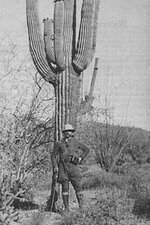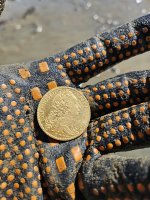Matthew Roberts
Bronze Member

Photo of Walter Gassler taken 1935.
Walter Karl Gassler’s 50-year search for the Lost Dutchman Goldmine ended tragically 34 years ago on May 4, 1984 when he was found dead in the Superstition Mountains. Walter was a true legend of the Superstitions. He hiked and camped, searched and dug and survived for half a century using nothing but a topo map, his energy and his instincts.
The debate continues today over how he died. Was it by natural causes, or had someone contributed to his death. Walter’s story of his life-long search was chronicled in 1989 on the television show Unsolved Mysteries.
Walter Gassler was born in Switzerland and came to New York city in the 1920’s. He traveled west to Los Angeles where he was employed as a master chef. His life-long passion was searching for lost treasure in the Superstition Mountains of Arizona.
Walter learned everything he could about the Lost Dutchman gold mine and its owner, Jacob Waltz. He spent considerable time in the Bancroft Library in Berkley California and other repositories of books and documents, reading everything he could find about Waltz and the lost mine legend and tales.
He spent time in the Superstition Mountains in the late 1920's before he resided in Arizona, making annual treks into the mountains searching for Waltz's lost mine. When he came to Arizona to settle he spent considerable time at Tex Barkley's Quarter Circle U ranch on the edge of the Superstition Mountains and became close friends with Barkley and his family.
One day at the Quarter Circle U ranch Walter and Tex Barkley were talking and Barkley told Walter a strange and intriguing story. He confessed to Walter that in 1931 he had found the body of Adolph Ruth, a missing prospector, on Peters Mesa. Barkley went on to say he and one of his wranglers, Tom Dickens, transported Ruth’s body off the Mesa and left it in a canyon where it was eventually found on the northeast side of Black Top Mesa.
According to Walter, Tex gave conflicting reasons for doing this. He told Walter he moved the body because he didn’t want hordes of people swarming all over his cattle range scattering his herd but also said that he had found a map on Ruth and with some friends followed that map to a cave marked on that map that was supposed to be the key to finding the lost mine. Barkley said this cave was located somewhere north of Peters Mesa. Once at the cave however, Barkley and the others were unable to locate the mine.
Tex Barkley went on to tell Walter that if he were to find the lost mine it would be somewhere in the vicinity of that cave and encouraged Walter to keep searching the area.
Walter continued his searching whenever time allowed him a few days away from work and family. He established a camp on Peters Mesa in a thick Laurel grove of trees on the west side of the Mesa. Walter’s camp was well hidden in that Laurel grove and unless you knew it was in that grove you would never guess it was there.
After an absence of several years from the Superstition Mountains Walter Gassler renewed his search for the Lost Dutchman Mine in the twilight of his years. Walter was now 80 and had written a 70-page manuscript that told the story of his 50-year search for the lost mine. Walter had located a mine that he believed to be the Lost Dutchman and had contacted a Los Angeles author and film-maker named Robert Lee. He corresponded with Lee for several months and Lee planned to make a documentary of Walter’s manuscript. All that remained for Walter to do was prove his mine was the Lost Dutchman. To accomplish that, Walter needed to claim the mine and collect samples of ore from the site.
So at the age of 80 Walter went back into the Superstition Mountains. His first trip back to his old camp in the Laurel grove ended badly. Walter realized he was in no condition to hike the mountains as he once had. He came back out of the Superstitions that time without realizing his goal. At this point, he knew he needed help to claim his mine and finish the work for Lee’s documentary.
One of the things that prompted Walter to hurry his claim was the Superstition Wilderness deadline. On January 1, 1984, the area of Walter’s mine became Wilderness and he would lose all rights to his find unless he filed on it before midnight of December 31, 1983.
It was the fall of 1983 when Walter contacted me and asked me for help. My camp on Peters Mesa was very near Walter’s camp and Walter always had access to my water, food and equipment I had cached on the Mesa whenever he was in the mountains. Walter asked me to go into the mountains and put up his claim monuments before the December 31st deadline. With the corner and center claim monuments erected Walter could go to the courthouse in Phoenix and file the claim papers with the recorder and everything would be legal. Walter supplied me with his topographic map which had the mine location marked and how he wanted the claim laid out. Then he filled out the claim location paper and gave it to me to put in a glass jar at the center monument of his claim.
I was able to put up Walter’s claim markers just before Christmas of 1983. I also took a few ore samples from the site as Walter had asked me to do.
In April of 1984 Walter at last felt he was able to make the hike into his mine to take samples for himself and photograph the mine for Lee’s documentary. At that time however a dangerous and troublesome individual, Crazy Jake Jacob, was causing a lot of trouble in Walter’s area and Walter did not want to have problems with Jake or Jake’s hired men. Walter contacted the Tonto National Forest office at Mesa and asked about Crazy Jakes activities. The Mesa Forest Service told him that Crazy Jake was indeed camped in the area and to avoid him and use extreme caution around him.
Robert Lee had told Walter it would be advisable for him to take someone into the mountains with him that would be a reliable witness to Walter’s claim of finding the Lost Dutchman Mine. Someone of integrity and well known throughout Arizona who would vouch for Walters claim.
In April of 1984 Walter approached two such men, one a former Arizona State official and the other a part time author and asked each of them if they would accompany him into the Superstitions to see his discoveries. Both men flatly refused his requests.
So on Monday April 30, 1984, Walter Gassler made his final trek into the Superstition Mountains alone. Five days later, on Friday May 4, 1984 two Apache Junction men on horseback came upon Walter Gassler sitting on a rock along the Peter's Mesa trail above Charley-Boy spring. Walter was dead and further up the trail were several armed men milling around looking down on the scene. The two riders identified the men above as some of Crazy Jakes hired men. Not wanting to become involved with Jake or his men neither rider dismounted.
Neither rider knew who Walter Gassler was and speculated the man’s death may have been due to some kind of confrontation between Jakes men and the deceased. Realizing they could do nothing for the dead man, both riders hurriedly turned around and left the scene to report the death to the authorities.
When a Pinal County Sheriff’s deputy arrived at the scene to investigate, he found Walter as the two riders had found him. It appeared to him Walter had died of a heart attack and later the Pinal County coroner confirmed that fact although no autopsy was performed.
Walter Gassler was found perched atop a small rock with no backing, almost like a person sitting on a small bar stool seat. At the time, it struck the Pinal County Sheriff’s deputy how a man could suffer the acute pain of a heart attack and die while perched upon such a small rock without falling off. The deputy noted that had the wind been blowing that day it would have blown the man off his perch. It seemed almost as if the deceased had been propped up on that rock in a sitting position by someone.
Among Walter’s possessions that he had with him at his death was a backpack that was reported to have contained some gold ore. Ore that Walter had most probably collected from his mine. Somehow that backpack with the ore went missing as did other items of Walter’s when someone pretending to be Walter’s son requested he be given his father’s map and possessions. No one has ever learned who the man who claimed to be Walter’s son was.
After Walter’s death a television documentary was done on Walter Gassler and his discovery but it wasn’t the documentary Walter and Robert Lee had planned. The television show Unsolved Mysteries did a one hour nationwide broadcast on the events surrounding Walter’s life long search and ultimate death in the Superstition Mountains.
Sadly, Robert Lee died in Los Angeles not long after Walter’s death and all hope for the Lee-Gassler documentary died with him. Walter Gassler did leave behind his manuscript which is a fascinating story of his search and a look into the way things were in the Superstitions in the 1930’s through the 1980’s. That manuscript can be found at the Superstition Mountain Museum in Apache Junction.
Walter Gassler will always be remembered as a good friend and one of the legendary characters of the Superstition Mountains and the search for the Lost Dutchman Goldmine.






